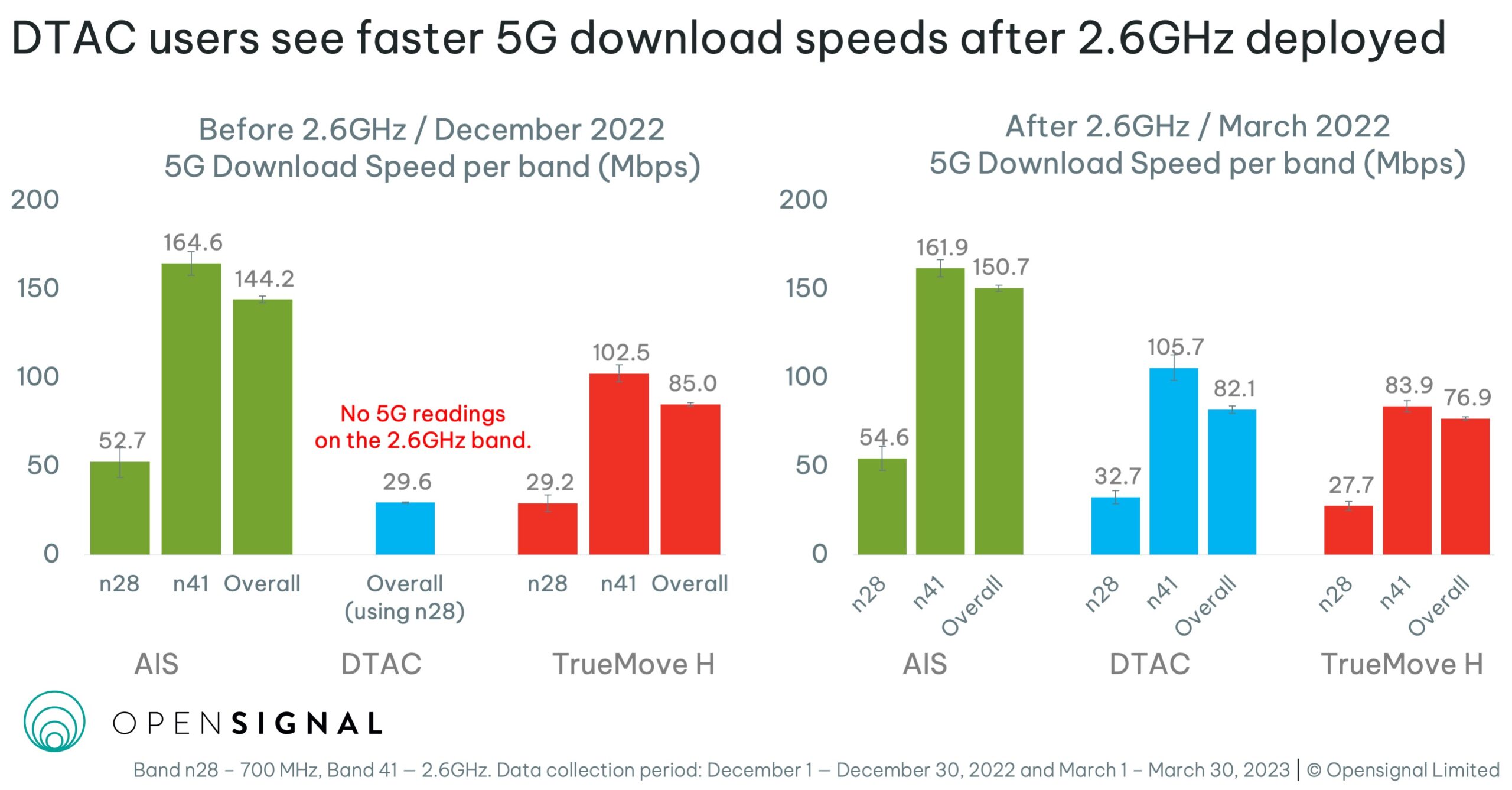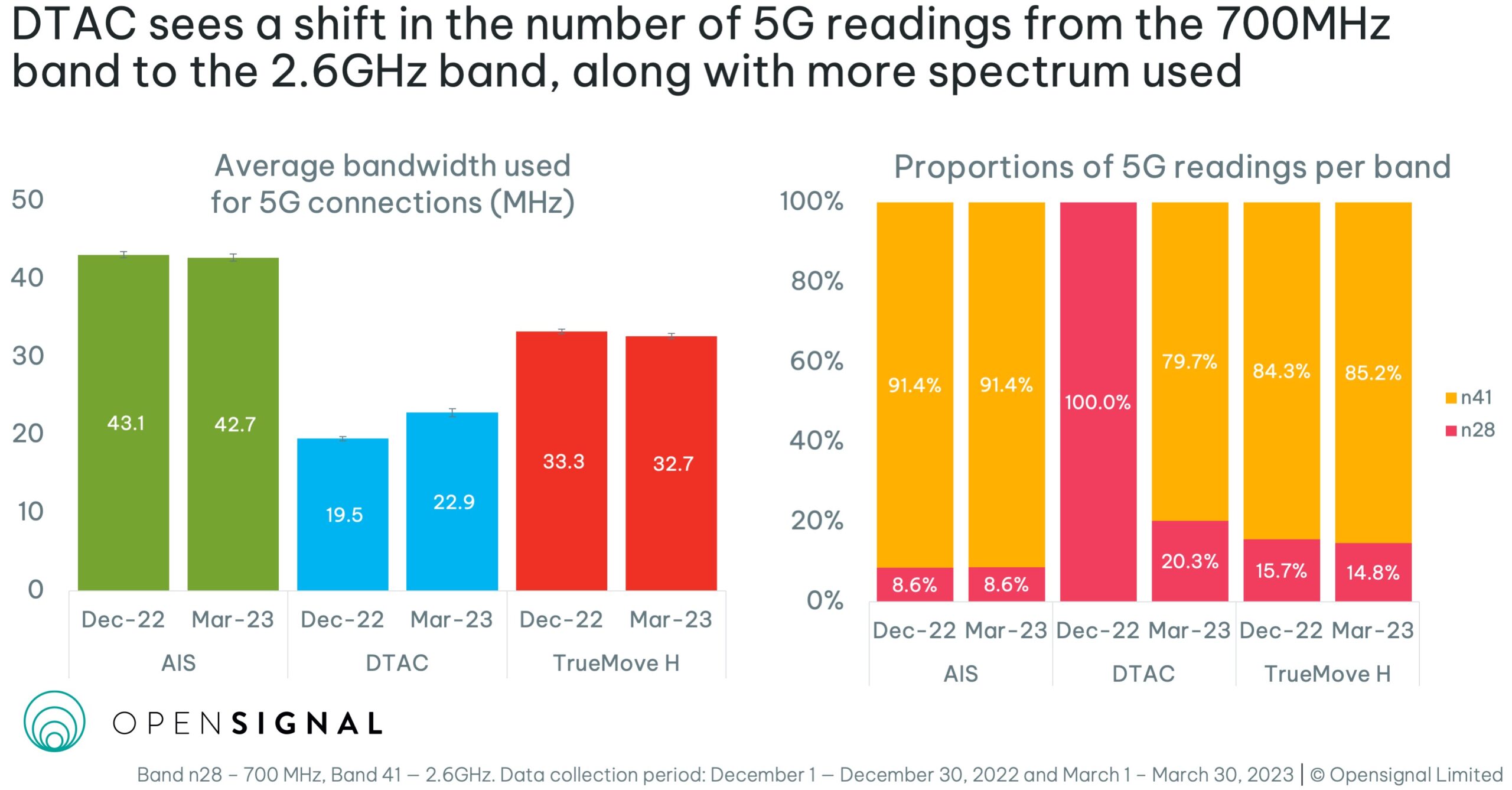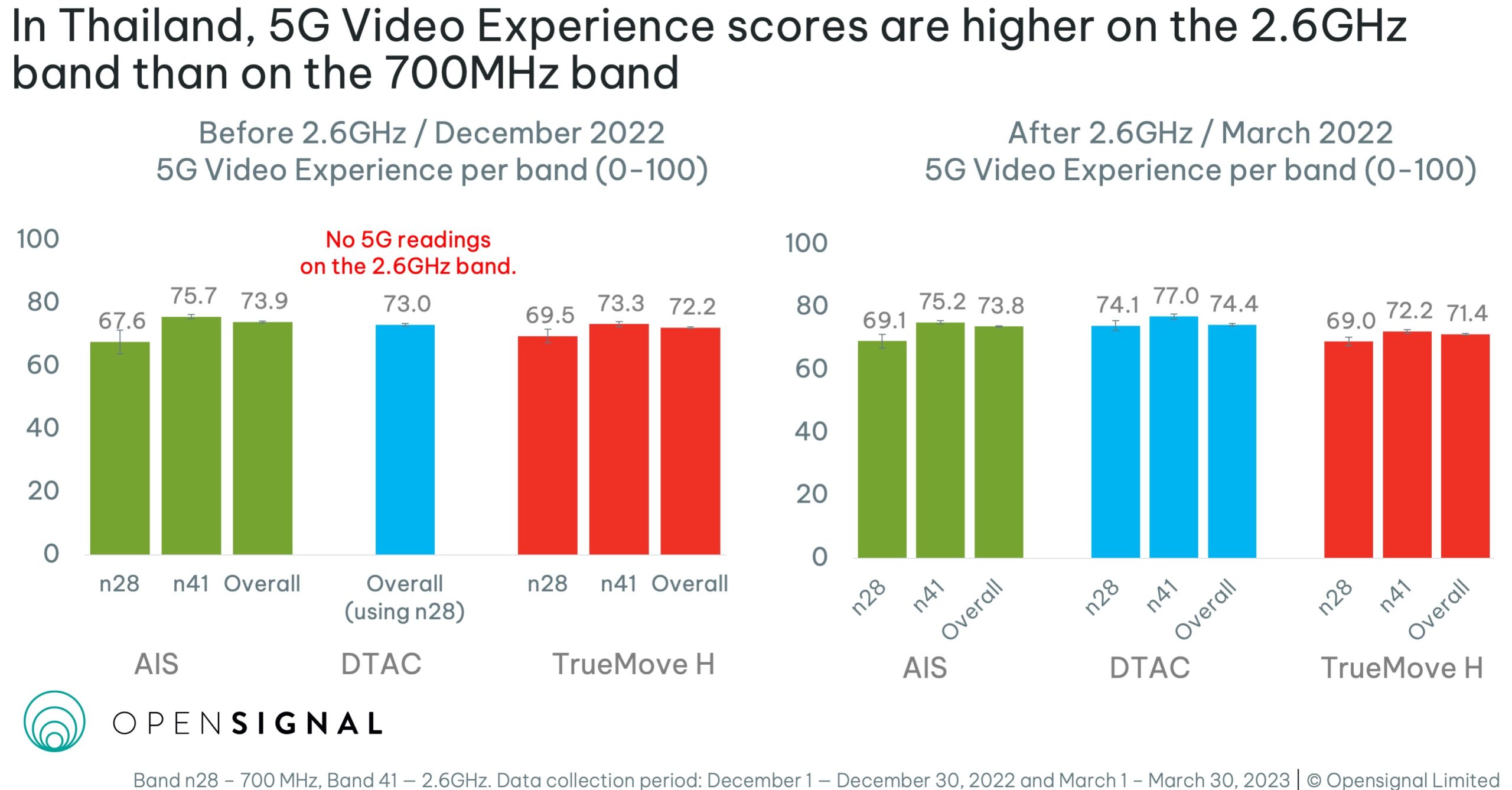By Robert Wyrzykowski, Senior Analyst at Opensignal
Opensignal data shows users have faster 5G speeds and better 5G Video Experience when connected to band n41 (2.6GHz). This spectrum band is becoming usable by more users because of the merger between DTAC and TrueMove H and as a result, is helping to boost their experience.
In this new analysis, Opensignal has compared the experience of our smartphone users on Thailand’s operators depending on the primary 5G band to which they connect, in December 2022 and March 2023 — before and after the completion of the DTAC and TrueMove H merger.
AIS users see the highest average amount of spectrum used for 5G connectivity of 42.7MHz in March 2023, which results in the fastest download speeds. However, while our DTAC users observed very low 5G speeds in December 2022, compared to the other two Thai operators, this changed in March 2023 — around the time of the merger. We saw a significant boost in experience at the time users started to access the 2.6GHz 5G band.
 Mobile operators in Thailand mainly use two spectrum bands for 5G — band n28 (700MHz) and band n41 (2.6GHz). The former provides wider coverage, but the latter ensures higher capacity — and, as a result, better throughput and faster speeds for mobile users.
Mobile operators in Thailand mainly use two spectrum bands for 5G — band n28 (700MHz) and band n41 (2.6GHz). The former provides wider coverage, but the latter ensures higher capacity — and, as a result, better throughput and faster speeds for mobile users.
There are substantial differences in spectrum holdings across the three main Thai operators. While AIS and TrueMove H have licenced 100MHz and 90MHz in the 2.6GHz band, respectively, DTAC did not secure any frequencies in this band during the 2020 spectrum auction — and, as a result, had to deploy 5G only in the 700MHz band. As we observed in December 2022 and in the latest Thailand Mobile Network Experience report, our users on this network struggled with much slower average 5G download speeds than their peers connecting on AIS or TrueMove H’s networks, around the 30Mbps mark.
However, the situation changed in March 2023, at the time of the completion of the merger between DTAC and TrueMove H. While the companies have yet to fully consolidate under the new True Corp brand, and network integration work continues, we have already observed 5G readings for DTAC users on the 2.6GHz band, part of which is currently licenced to TrueMove — with 5G Download Speed clocking in at 105.7Mbps, more than three times faster than on the 700MHz band. As a result, DTAC’s average overall 5G download increased 2.8 times in March 2023, compared to December 2022 — from 29.6Mbps to 82.1Mbps. Interestingly, TrueMove H’s 5G download speeds on the 2.6GHz band dropped substantially from 102.5Mbps in December to 83.9Mbps in March 2023, which would be partially attributed to both companies sharing the 2.6GHz band now.
 Opensignal looked at the evolution of the average spectrum bandwidth used by 5G connections on different Thai operators between December 2022 and March 2023. The average 5G spectrum bandwidth used on DTAC’s network jumped from 19.5MHz in December 2022 to 22.9MHz in March — increasing by 3.4MHz (17.1%) since December. There were no statistically significant changes in the average spectrum bandwidth used by our AIS and TrueMove H users’ 5G connections between these months.
Opensignal looked at the evolution of the average spectrum bandwidth used by 5G connections on different Thai operators between December 2022 and March 2023. The average 5G spectrum bandwidth used on DTAC’s network jumped from 19.5MHz in December 2022 to 22.9MHz in March — increasing by 3.4MHz (17.1%) since December. There were no statistically significant changes in the average spectrum bandwidth used by our AIS and TrueMove H users’ 5G connections between these months.
Looking at how the proportions of 5G readings per band changed between December 2022 and March 2023 for different operators — there’s a strong shift on DTAC’s network from the 700MHz (n28) to the 2.6GHz (n41) band. While in December 2022 DTAC still relied entirely on the 700MHz band to provide 5G services — the 2.6GHz band rocketed to nearly 80% of 5G readings on DTAC in March 2023. We did not observe a substantial shift in the case of AIS and TrueMove H, as the proportions of 5G readings on the 700MHz band remained stable between December 2022 and March 2023 — around 8.6% and 15.2%, respectively.
 Not only does the increased spectrum bandwidth contribute to faster 5G download speeds, but also improves the quality of other mobile services. Opensignal analyzed 5G Video Experience scores for Thailand’s operators depending on the primary 5G band used. We observed that our Thai 5G users generally enjoy a better video experience when they connect to 5G services over the 2.6GHz band than over the 700MHz band — with the differences in scores in March 2023 ranging from 2.9 and 3.2 points for DTAC and TrueMove H, respectively, to six points for AIS.
Not only does the increased spectrum bandwidth contribute to faster 5G download speeds, but also improves the quality of other mobile services. Opensignal analyzed 5G Video Experience scores for Thailand’s operators depending on the primary 5G band used. We observed that our Thai 5G users generally enjoy a better video experience when they connect to 5G services over the 2.6GHz band than over the 700MHz band — with the differences in scores in March 2023 ranging from 2.9 and 3.2 points for DTAC and TrueMove H, respectively, to six points for AIS.
Similarly to 5G Download Speed, Opensignal saw no significant volume of 5G readings on the 2.6GHz band for DTAC in December 2022. However, in March 2023, we observed 5G connections using this band on DTAC’s network, with higher 5G Video Experience scores than on the 700MHz band.
The new operator has the potential to shake the mobile market
We’ve seen a newly merged operator change its market position in other countries. Our recent analysis of Italy’s competitive landscape shows that Wind and Tre joining forces in 2020 led to the creation of a market player that was able to disrupt the Italian market and win several mobile network experience awards in Opensignal reports.
AIS has been dominating the awards tables in the Opensignal Thailand Mobile Network Experience reports published in May 2022 and November 2022, when it won all the 5G speed and experiential awards outright. With their infrastructure and spectrum licenses combined, along with their customer bases, the DTAC-TrueMove H merger gives the company new assets to help it to create a stronger challenge to AIS in the mobile network experience.
โดย โรเบิร์ต วิซีคอฟสกี้ นักวิเคราะห์อาวุโส Opensignal
ข้อมูลจาก Opensignal แสดงให้เห็นว่าผู้ใช้ได้สัมผัสกับความเร็ว 5G ที่สูงขึ้นพร้อมได้รับประสบการณ์วิดีโอ 5G ที่ดียิ่งขึ้นเมื่อเชื่อมต่อผ่านย่านความถี่ n41 (2.6GHz) และมีผู้ใช้ย่านความถี่นี้กันมากขึ้น ซึ่งเป็นความถี่ที่เกิดจากการควบรวมกิจการของ DTAC และ TrueMove H ส่งผลให้ผู้ใช้ได้รับประสบการณ์ดียิ่งขึ้น
การวิเคราะห์ครั้งใหม่นี้ Opensignal ได้เปรียบเทียบประสบการณ์การเชื่อมต่อ 5G ของผู้ใช้สมาร์ทโฟนบนเครือข่ายมือถือของผู้ให้บริการต่าง ๆ ของประเทศไทยในเดือนธันวาคม 2565 และเดือนมีนาคม 2566 ซึ่งเป็นช่วงเวลาก่อนและหลังการสิ้นสุดกระบวนการการควบรวมกิจการระหว่าง DTAC และ TrueMove H
ในเดือนมีนาคม 2566 ผู้ใช้เครือข่าย AIS ได้รับประสบการณ์การเชื่อมต่อ 5G ด้วยความเร็วเฉลี่ยสูงสุดด้วยคลื่นความถี่ 42.7 MHz จึงเป็นเครือข่ายที่มีความเร็วในการดาวน์โหลดสูงสุด ขณะเดียวกันเมื่อเดือนธันวาคม 2565 ผู้ใช้เครือข่าย DTAC ได้พบกับความเร็ว 5G ในระดับต่ำมาก เมื่อเปรียบเทียบกับผู้ให้บริการเครือข่ายอีกสองรายในประเทศไทย ทว่าช่วงเวลาของการควบรวมกิจการในเดือนมีนาคม 2566 เราสังเกตเห็นถึงการเปลี่ยนแปลงด้านความเร็วอย่างมีนัยยะของประสบการณ์ต่าง ๆ ของ DTAC เมื่อผู้ใช้เชื่อมต่อผ่านย่านความถี่ 2.6GHz
 ผู้ให้บริการเครือข่ายในประเทศไทยใช้ย่านความถี่ 5G อยู่สองประเภทคือย่านความถี่ n28 (700MHz) และย่านความถี่ n41 (2.6 GHz) โดยแบบแรกจะให้ความถี่ครอบคลุมในช่วงกว้างกว่าและแบบที่สองจะให้ความจุข้อมูลสูงกว่า สิ่งนี้เองที่ทำให้มีปริมาณข้อมูลและความเร็วที่เพิ่มขึ้นสำหรับผู้ใช้มือถือ
ผู้ให้บริการเครือข่ายในประเทศไทยใช้ย่านความถี่ 5G อยู่สองประเภทคือย่านความถี่ n28 (700MHz) และย่านความถี่ n41 (2.6 GHz) โดยแบบแรกจะให้ความถี่ครอบคลุมในช่วงกว้างกว่าและแบบที่สองจะให้ความจุข้อมูลสูงกว่า สิ่งนี้เองที่ทำให้มีปริมาณข้อมูลและความเร็วที่เพิ่มขึ้นสำหรับผู้ใช้มือถือ
มีความแตกต่างอย่างมีนัยยะสำคัญของการถือครองคลื่นความถี่ของผู้ให้บริการเครือข่ายทั้งสามรายในประเทศไทย ขณะที่ AIS และ TrueMove H เป็นผู้ถือครองกรรมสิทธิ์ความถี่100 MHz และ 90 MHz ในความถี่ 2.6GHz นั้น DTAC กลับไม่ได้ถือครองกรรมสิทธิ์ในคลื่นความถี่ใดในย่านความถี่นี้ในการประมูลคลื่นความถี่ประจำปี 2563 — จึงเป็นผลทำให้สามารถกระจายสัญญาณ 5G ในย่านความถี่ 700 MHz ได้เท่านั้น โดยข้อมูลนี้เป็นข้อมูลที่เราสังเกตมาตั้งแต่เดือนธันวาคม 2565 และในรายงานประสบการณ์เครือข่ายมือถือประจำประเทศไทย ครั้งล่าสุดนี้ที่ผู้ใช้เครือข่าย DTAC ของเรา ได้พบกับค่าเฉลี่ยความเร็วในการดาวน์โหลด 5G ในระดับต่ำมากเมื่อเปรียบเทียบกับการเชื่อมต่อบน AIS และ TrueMove H ประมาณ 30Mbps
อย่างไรก็ตาม สถานการณ์ได้เปลี่ยนแปลงไปในเดือนมีนาคม 2566 ในช่วงการสิ้นสุดกระบวนการการควบรวมกิจการระหว่าง DTAC และ TrueMove H ขณะที่ทั้งสองบริษัทยังไม่ได้ถูกควบรวมให้อยู่ภายใต้เครื่องหมายการค้า True Corp ใหม่อย่างเต็มรูปแบบและการควบรวมเครือข่ายยังคงอยู่ในขั้นตอนการดำเนินงาน เราสังเกตเห็นว่าผู้ใช้ 5G บนเครือข่าย DTAC ในย่านความถี่ 2.6 GHz ที่เป็นกรรมสิทธิ์ของ TrueMove H ในเวลานี้ได้รับประสบการณ์ความเร็วในการดาวน์โหลด 5G เป็น 105.7 Mbps ซึ่งมีความเร็วสูงกว่าย่านความถี่ 700 MHz ถึงสามเท่า ด้วยเหตุนี้จึงทำให้ ในเดือนมีนาคม 2566 ค่าเฉลี่ยโดยรวมในการดาวน์โหลด 5G ของ DTAC เพิ่มขึ้น 2.8 เท่า หากเทียบกับในเดือนธันวาคม 2565 แล้วนับว่ามีความเร็วเพิ่มขึ้นจาก 29.6Mbps เป็น 82.1Mbps สิ่งที่น่าสนใจคือ ความเร็วในการดาวน์โหลด 5G ของ TrueMove H บนความถี่ 2.6GHz นั้นลดลงจากในเดือนธันวาคม 2565 ที่ 102.5Mbps เหลือเพียง 83.9Mbps ในเดือนมีนาคม 2566 ส่วนหนึ่งเป็นผลจากการใช้ย่านความถี่ 2.6GHz ร่วมกันของทั้งสองบริษัท
 Opensignal ได้พิจารณาพัฒนาการด้านแบนด์วิธคลื่นความถี่โดยเฉลี่ยของการเชื่อมต่อ 5G บนเครือข่ายของผู้ให้บริการในประเทศไทยระหว่างเดือนธันวาคม 2565 และเดือนมีนาคม 2566 พบว่าแบนด์วิธคลื่นความถี่ 5G โดยเฉลี่ยของเครือข่าย DTAC เพิ่มขึ้นอย่างก้าวกระโดดจาก 19.5MHz ในเดือนธันวาคม 2565 เป็น 22.9MHz ในเดือนมีนาคมซึ่งเพิ่มขึ้น 3.4MHz (17.1%) นับตั้งแต่เดือนธันวาคมเป็นต้นมา สำหรับผู้ใช้ที่เชื่อมต่อ 5G บนเครือข่าย AIS และ TrueMove H นั้นยังไม่พบการเปลี่ยนแปลงทางสถิติของค่าเฉลี่ยแบนด์วิธคลื่นความถี่ใด ๆ ในช่วงเดือนดังกล่าว
Opensignal ได้พิจารณาพัฒนาการด้านแบนด์วิธคลื่นความถี่โดยเฉลี่ยของการเชื่อมต่อ 5G บนเครือข่ายของผู้ให้บริการในประเทศไทยระหว่างเดือนธันวาคม 2565 และเดือนมีนาคม 2566 พบว่าแบนด์วิธคลื่นความถี่ 5G โดยเฉลี่ยของเครือข่าย DTAC เพิ่มขึ้นอย่างก้าวกระโดดจาก 19.5MHz ในเดือนธันวาคม 2565 เป็น 22.9MHz ในเดือนมีนาคมซึ่งเพิ่มขึ้น 3.4MHz (17.1%) นับตั้งแต่เดือนธันวาคมเป็นต้นมา สำหรับผู้ใช้ที่เชื่อมต่อ 5G บนเครือข่าย AIS และ TrueMove H นั้นยังไม่พบการเปลี่ยนแปลงทางสถิติของค่าเฉลี่ยแบนด์วิธคลื่นความถี่ใด ๆ ในช่วงเดือนดังกล่าว
เมื่อพิจารณาสัดส่วนของการเปลี่ยนแปลงของ 5G ต่อย่านความถี่ในเดือนธันวาคม 2565 และเดือนมีนาคม 2566 ของผู้ให้บริการเครือข่ายต่าง ๆ แล้ว พบว่าเครือข่าย DTAC มีการเปลี่ยนแปลงอย่างมากโดยเปลี่ยนจากความถี่ 700MHz (n28) เป็น 2.6 GHz (n41) ขณะที่ในเดือนธันวาคม 2565 นั้น DTAC ยังคงใช้คลื่นความถี่ 700MHz ให้บริการ 5G แต่ในเดือนมีนาคม 2566 ในการอ่านค่า 5G ของเครือข่าย DTAC พบว่ามีการให้บริการบนคลื่นความถี่ 2.6GHz เพิ่มขึ้นเกือบ 80% ซึ่งเราไม่พบการเปลี่ยนแปลงลักษณะนี้กับเครือข่าย AIS และ TrueMove H ด้วยสัดส่วนของ 5G ในคลื่นความถี่ 700MHz ยังคงเป็นไปอย่างปรกติทั้งในเดือนธันวาคม 2565 และเดือนมีนาคม 2566 ซึ่งอยู่ในช่วง 8.6% และ 15.2% ตามลำดับ
 แบนด์วิธความถี่ที่เพิ่มขึ้นไม่เพียงแต่ทำให้ความเร็วในการดาวน์โหลด 5G สูงขึ้นเท่านั้น แต่ยังช่วยพัฒนาคุณภาพการบริการมือถือในด้านอื่น ๆ อีกด้วย Opensignal ได้วิเคราะห์คะแนนด้านประสบการณ์วิดีโอ 5G ตามคลื่นความถี่ 5G ที่ผู้ให้บริการเครือข่ายในประเทศไทยใช้เป็นหลัก พบว่าการเชื่อมต่อ 5G บนย่านความถี่ 2.6MHz ทำให้ผู้ใช้ 5G ชาวไทยได้รับประสบการณ์วิดีโอที่ดีกว่าการเชื่อมต่อบนย่านความถี่ 700 MHz ด้วยค่าคะแนนที่แตกต่างกันในเดือนมีนาคม 2566 ในช่วงคะแนน 2.9 และ 3.2 สำหรับ DTAC และ TrueMove H ตามลำดับ และ 6 คะแนนสำหรับ AIS
แบนด์วิธความถี่ที่เพิ่มขึ้นไม่เพียงแต่ทำให้ความเร็วในการดาวน์โหลด 5G สูงขึ้นเท่านั้น แต่ยังช่วยพัฒนาคุณภาพการบริการมือถือในด้านอื่น ๆ อีกด้วย Opensignal ได้วิเคราะห์คะแนนด้านประสบการณ์วิดีโอ 5G ตามคลื่นความถี่ 5G ที่ผู้ให้บริการเครือข่ายในประเทศไทยใช้เป็นหลัก พบว่าการเชื่อมต่อ 5G บนย่านความถี่ 2.6MHz ทำให้ผู้ใช้ 5G ชาวไทยได้รับประสบการณ์วิดีโอที่ดีกว่าการเชื่อมต่อบนย่านความถี่ 700 MHz ด้วยค่าคะแนนที่แตกต่างกันในเดือนมีนาคม 2566 ในช่วงคะแนน 2.9 และ 3.2 สำหรับ DTAC และ TrueMove H ตามลำดับ และ 6 คะแนนสำหรับ AIS
เช่นเดียวกับด้านความเร็วในการดาวน์โหลด 5G ในเดือนธันวาคม 2565 Opensignal ยังไม่พบการให้บริการ 5G บนย่านความถี่ 2.6GHz ของ DTAC แต่เดือนมีนาคม 2566 เราพบว่ามีการเชื่อมต่อ 5G บนเครือข่าย DTAC บนย่านความถี่นี้ และยังได้รับคะแนนประสบการณ์วิดีโอ 5G ที่เพิ่มขึ้นมากกว่าการเชื่อมต่อบนย่านความถี่ 700MHz
ผู้ให้บริการรายใหม่มีศักยภาพเขย่าตลาดมือถือ
เราพบว่าในประเทศอื่น ๆ ที่มีผู้ให้บริการรายใหม่เกิดขึ้นจากการควบรวมกิจการได้เปลี่ยนตำแหน่งของตนเองไปอย่างสิ้นเชิง จากการวิเคราะห์ล่าสุดถึงแนวโน้มการแข่งขันในอิตาลี แสดงให้เห็นว่าการควบรวมกิจการของ Wind และ Tre ในปี 2563 นำไปสู่การเกิดขึ้นของผู้ให้บริการใหม่ที่พลิกโฉมตลาดอิตาลีได้และยังคว้ารางวัลประสบการณ์เครือข่ายมือถืออีกหลายรางวัลในรายงานของ Opensignal
AIS ครองรางวัลในรายงานประสบการณ์เครือข่ายมือถือของประเทศไทยจาก Opensignal ที่เผยแพร่เมื่อเดือนพฤษภาคม 2565 และ พฤศจิกายน 2565 โดยคว้ารางวัลชนะเลิศด้านความเร็ว 5G และรางวัลด้านประสบการณ์ทั้งหมด ส่วน DTAC และ TrueMove H จากกรณีการควบรวมกิจการที่ทำให้มีกรรมสิทธิ์ในคลื่นความถี่และโครงสร้างพื้นฐาน ตลอดจนฐานผู้ใช้ที่มากขึ้น ทำให้บริษัทกลายเป็นคู่แข่งสำคัญของ AIS ในด้านประสบการณ์เครือข่ายมือถือ
 ผู้ให้บริการเครือข่
ผู้ให้บริการเครือข่ Opensignal ได้พิจารณาพัฒนาการด้านแบนด์วิ
Opensignal ได้พิจารณาพัฒนาการด้านแบนด์วิ แบนด์วิธความถี่ที่เพิ่มขึ้นไม่เพียงแต่ทำให้ความเร็วในการดาวน์โหลด 5G สูงขึ้นเท่านั้น แต่ยังช่วยพัฒนาคุณภาพการบริการมือถือในด้านอื่น ๆ อีกด้วย Opensignal ได้วิเคราะห์คะแนนด้านประสบการณ์วิดีโอ 5G ตามคลื่นความถี่ 5G ที่ผู้ให้บริการเครือข่ายในประเทศไทยใช้เป็นหลัก พบว่าการเชื่อมต่อ 5G บนย่านความถี่ 2.6MHz ทำให้ผู้ใช้ 5G ชาวไทยได้รับประสบการณ์วิดีโอที่ดีกว่าการเชื่อมต่อบนย่านความถี่ 700 MHz ด้วยค่าคะแนนที่แตกต่างกันในเดือนมีนาคม 2566 ในช่วงคะแนน 2.9 และ 3.2 สำหรับ DTAC และ TrueMove H ตามลำดับ และ 6 คะแนนสำหรับ AIS
แบนด์วิธความถี่ที่เพิ่มขึ้นไม่เพียงแต่ทำให้ความเร็วในการดาวน์โหลด 5G สูงขึ้นเท่านั้น แต่ยังช่วยพัฒนาคุณภาพการบริการมือถือในด้านอื่น ๆ อีกด้วย Opensignal ได้วิเคราะห์คะแนนด้านประสบการณ์วิดีโอ 5G ตามคลื่นความถี่ 5G ที่ผู้ให้บริการเครือข่ายในประเทศไทยใช้เป็นหลัก พบว่าการเชื่อมต่อ 5G บนย่านความถี่ 2.6MHz ทำให้ผู้ใช้ 5G ชาวไทยได้รับประสบการณ์วิดีโอที่ดีกว่าการเชื่อมต่อบนย่านความถี่ 700 MHz ด้วยค่าคะแนนที่แตกต่างกันในเดือนมีนาคม 2566 ในช่วงคะแนน 2.9 และ 3.2 สำหรับ DTAC และ TrueMove H ตามลำดับ และ 6 คะแนนสำหรับ AIS